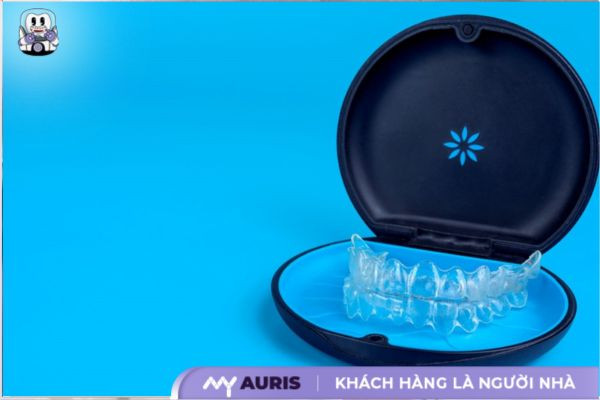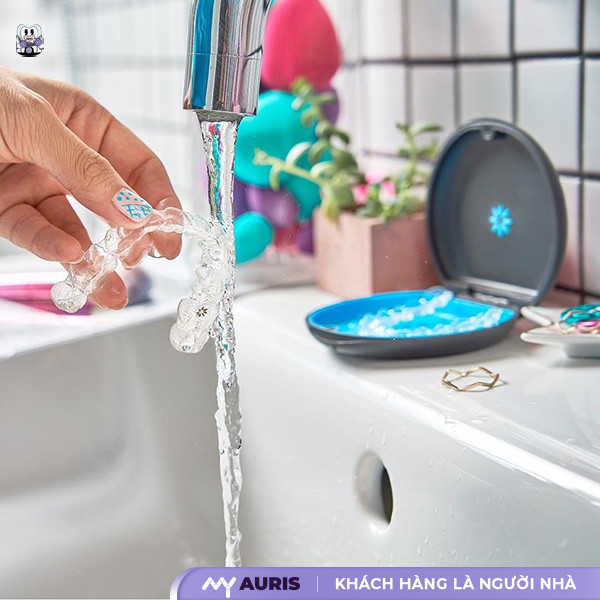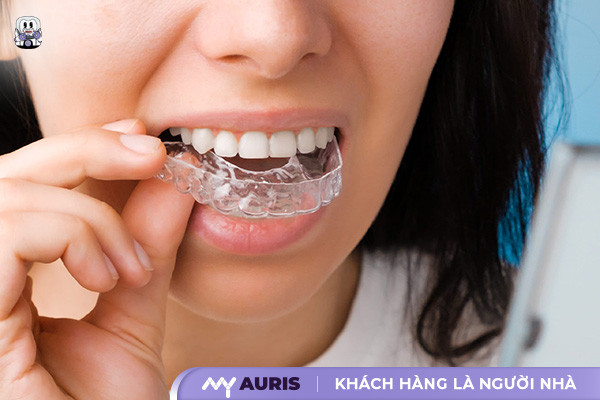Clear aligner braces are an increasingly popular orthodontic method. Many people wonder if clear aligners hurt. My Auris Dental will answer this question, helping you better understand the sensations when wearing clear aligners.
Does Clear Aligner Braces Hurt?
Does clear aligner braces hurt? This is a common question for many people before deciding on this modern orthodontic method. According to dental experts, wearing clear aligners can cause a dull ache or discomfort, especially in the first few days after changing to a new aligner tray. However, the level of pain is usually mild and completely manageable, not severely impacting daily activities.
Whether it’s clear aligners or traditional braces, the common goal is to apply force to the tooth roots and surrounding ligaments, thereby shifting the teeth into their correct positions. This force is the main cause of some discomfort.

Initial Stage: Getting Used to the Tightening Force
In the first few days, you may feel a slight dull ache in your teeth and gums as your mouth begins to adapt to the tightening force from the aligner trays. This sensation usually lasts only a few days and then gradually subsides.
When Changing to New Aligners: Temporary Pain
Each time you change to a new aligner tray, the applied force increases, causing pain for 2-3 days. This is when many people feel the most discomfort; however, you can effectively relieve pain with painkillers or cold compresses.
Middle Stage: Teeth Begin Stable Movement
At this point, teeth have begun to move steadily, and the pain sensation will significantly decrease, with only occasional mild pain appearing as teeth continue to adjust.
Final Stage: Almost No Pain
Once the teeth are stable in their desired position, the pain sensation almost completely disappears, making you much more comfortable.

How to Relieve Pain When Wearing Clear Aligner Braces?
Concerns about severe pain, discomfort, soreness, and aches make many people hesitant about cosmetic orthodontic treatment. Comparing the pain level between clear aligners and traditional braces is also a patient concern. You want to find solutions to alleviate brace pain and minimize the side effects of clear aligners.
Here are some effective pain relief measures you can apply:
Use Painkillers: Your orthodontist may prescribe over-the-counter pain relievers such as ibuprofen or paracetamol. Take medication before changing to a new aligner tray to minimize discomfort. Follow the recommended dosage.
Apply Cold Compress: Apply a cold pack to the painful area outside your mouth and cheek. Cold compresses help reduce swelling and mildly numb the painful area.
Rinse with Warm Saltwater: Warm saltwater helps soothe gums and reduce inflammation. Rinse several times a day, especially after meals. Thorough oral hygiene is crucial during dental treatment.
Eat Soft Foods: In the first few days after changing aligner trays, opt for soft, easy-to-chew foods like porridge, soup, or smoothies. Avoid hard, chewy foods that require strong chewing force.
Use Orthodontic Wax: Orthodontic wax helps protect gums and cheeks from irritation caused by the aligner trays. Apply wax to the areas of the aligner causing discomfort.
Follow Your Dentist’s Instructions: Wear aligner trays for the prescribed duration (usually 22 hours/day). Remove trays correctly for eating and oral hygiene. Contact your dentist if the pain persists or affects your sleep.
Factors Affecting Pain When Wearing Clear Aligner Braces
The degree of pain when wearing clear aligners depends on many factors. Understanding these factors will help you better prepare for the cosmetic orthodontic treatment process and minimize discomfort:
Complexity of the Treatment Case
Each patient has a different oral condition. The complexity of the treatment case directly affects the treatment duration and the level of pain. In cases of severely misaligned teeth requiring significant movement, the longer the treatment time, the more intense the pain may be. Conversely, for simple clear aligner cases that only require slight tooth movement, discomfort will be less. Your orthodontist will assess your dental condition and propose an appropriate treatment plan.

Aligner Material
Clear aligner trays are made from special plastic. Each type of plastic has different hardness and elasticity, affecting the force applied to the teeth and gums, causing soreness. Patients should discuss with their dentist to choose the appropriate aligner type, ensuring treatment effectiveness and comfort.
Aligner Wearing Time
Adhering to the aligner wearing time as prescribed by the dentist is crucial. Wearing the trays for a sufficient duration (usually 22 hours/day) helps teeth move in the correct direction and minimizes pain. Removing the trays too frequently can disrupt the treatment process, prolong the duration of braces, and cause significant discomfort.
Oral Hygiene
Proper oral hygiene helps prevent inflammation, reduces gum irritation, and alleviates pain during braces treatment. Thorough oral care, using dental floss and mouthwash, helps remove plaque and bacteria, keeps the mouth clean, and minimizes the side effects of clear aligners.

Body Adaptation
Everyone has a different pain threshold and ability to adapt. Some patients experience pain in the first few days when starting a new aligner tray, while others only feel mild discomfort. Pain and discomfort during braces treatment are natural bodily reactions as teeth and gums adapt to the force exerted by the aligner trays.
Patient Psychology
Psychology also affects a patient’s subjective perception of pain levels. Anxiety and stress can increase feelings of pain and discomfort. Maintaining a relaxed and optimistic mindset helps you get through the treatment process more easily. Discuss your concerns with your dentist for advice and support.
Comparing Pain Levels Between Clear Aligner Braces and Traditional Braces
When choosing an orthodontic method, many people wonder whether clear aligners or traditional braces cause less pain, soreness, or discomfort. In reality, both methods can cause a feeling of bulkiness and lip irritation in the initial stage, but the level of pain varies depending on oral condition, pain threshold, and individual adaptability.
Thanks to their special design and gentler force, clear aligner trays typically provide a more comfortable experience compared to traditional bracket and wire systems. The table below will help you better understand the differences:
| Feature | Clear Aligner Braces | Traditional Braces |
| Initial pain level | Mild soreness, easy to adapt | Significant pain in the first few days due to tightening force from brackets and wires |
| When changing trays / adjusting wires | Feeling of bulkiness, slight discomfort for the first few hours | Noticeable pain, can last several days |
| During treatment | Stable pain level, gradually decreases over time | May experience periods of more intense pain when wires are tightened |
| When eating/chewing | Less painful as aligners can be removed for eating, cleaned, and then reinserted | May be painful when food gets stuck in brackets or wires |
| When speaking | Less impact, not much lip irritation | May cause lip irritation, slightly affecting pronunciation |
| Influencing factors | Oral condition, applied force, individual pain threshold | Similar to clear aligners but the force can be stronger |
| Adaptation time | Faster, usually after a few days | May take longer to get used to |
Clear Aligner Braces – Pros and Cons
Pros
Clear aligner trays are almost invisible, helping you communicate confidently without worrying about aesthetic issues. Being discreet during interaction is a major advantage, especially for those in professions requiring frequent contact.
Less irritating to gums and cheeks compared to traditional braces, minimizing discomfort during orthodontic treatment. Patients can easily maintain oral hygiene as the trays are removable. This helps prevent dental problems throughout the treatment process.
Easy removability allows you to eat and maintain oral hygiene comfortably. You don’t have to restrict many types of food as with traditional braces. Oral care also becomes simpler.
Modern technology allows you to preview treatment results, helping you visualize your future smile more clearly. This helps patients feel more confident about the effectiveness of the treatment.
Depending on the complexity of each case, treatment time may be shorter compared to traditional braces. However, strict adherence to wearing the trays for sufficient time each day is crucial for achieving the best treatment results.

Cons
Clear aligner braces are often more expensive than traditional braces. The cost of braces is an important factor to consider.
Requires strict adherence from the patient to wear the trays. If not worn for 22 hours daily, treatment effectiveness will be affected.
This method is not effective for complex cases that require more intensive intervention.
Some patients may experience discomfort, pain, or soreness during the initial adjustment period with the aligner trays. The level of pain, discomfort, and frequency of sharp pains will gradually decrease as the body adapts.
Initially, the aligner trays may affect speech, causing difficulty in communication.
Aligner trays need to be cleaned regularly to prevent bacterial buildup, which can affect oral health.

Clear Aligner Braces Procedure and Some Notes
The clear aligner braces procedure, a dental service within the field of dental treatment, is scientifically designed to ensure patient comfort and effectiveness. Here are the detailed steps:
Examination and Consultation: Patients visit the orthodontist for a general examination of their oral condition. The orthodontist will assess the degree of tooth misalignment, take photos, make impressions, and analyze them using specialized software. Patients will be advised on the treatment method, duration, cost of braces, and the pros and cons of clear aligners. Notably, Invisalign, a popular brand of clear aligners, will be introduced if suitable.
Treatment Planning: Based on the analysis results, the orthodontist will develop a detailed treatment plan, including the number of aligner trays to be used, the wearing time for each tray, and a prediction of the final outcome. This plan will be shared with the patient to ensure transparency and agreement.
Aligner Production: Clear aligner trays are custom-made for each patient based on dental impressions and the treatment plan. The materials used are safe and cause minimal irritation to gums and cheeks. High aesthetics and easy removability are advantages of clear aligners.
Wearing Aligners: Patients will be instructed on how to properly insert and remove the aligner trays. The minimum wearing time for the trays is 22 hours per day. Adhering to the wearing time directly impacts the treatment’s effectiveness.
Regular Check-ups: Patients need to attend regular follow-up appointments with their dentist to check tooth movement, adjust aligner trays, and maintain oral hygiene. During treatment, patients may experience discomfort from braces, but the pain level is usually mild and manageable.
Notes After Clear Aligner Treatment
Understanding the notes after clear aligner treatment is key to effective cosmetic orthodontic results and comfort:
Proper Oral Hygiene
Thorough oral hygiene is the most important factor in dental treatment, especially with clear aligners. You need to brush your teeth after every meal, removing plaque from teeth and gums, preventing cavities and gum problems. Use a soft-bristled toothbrush, fluoride toothpaste, and dental floss to clean between teeth. Rinsing with specialized mouthwash also helps remove bacteria, leaving fresh breath.
Reasonable Diet
During orthodontic treatment, you should avoid hard, chewy, sticky foods such as chewing gum, hard bread, or overly sweet snacks. These foods can damage clear aligners, affect treatment effectiveness, and cause pain. Prioritize soft, easy-to-chew foods like porridge, soup, smoothies, and soft fruits. Drinking plenty of water also helps clean your mouth and keeps your clear aligner trays clean.
Adhere to Orthodontist Instructions
Regular follow-up appointments with your dentist are essential. The dentist will monitor treatment progress, adjust aligner trays, and answer any questions you may have. Strictly adhering to your dentist’s instructions and wearing the aligner trays for sufficient time (usually 22 hours per day) are crucial factors for the success of this orthodontic method.
Handling Emergency Situations
If an aligner tray breaks, cracks, or is lost, contact your dentist immediately for advice and prompt resolution. Avoid attempting to repair or use old aligner trays on your own, as this can negatively impact the orthodontic treatment process.
Managing Discomfort
During the initial period of wearing aligner trays, you may experience discomfort, mild pain, or soreness in your teeth and gums. This is a normal phenomenon as your teeth are shifting. Use painkillers as prescribed by your dentist to minimize pain and discomfort. Rinsing with warm salt water also helps soothe gums, reduce swelling, and alleviate aches. If the pain is too severe or prolonged, contact your dentist immediately.
Monitoring and Evaluation
Record your sensations, pain level, specific pain location, impact on sleep, and compare it with other types of pain. Monitor the pain level throughout each treatment stage. This information will help your dentist evaluate treatment effectiveness and adjust the treatment plan if necessary.





